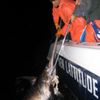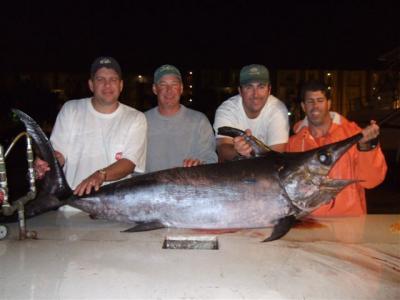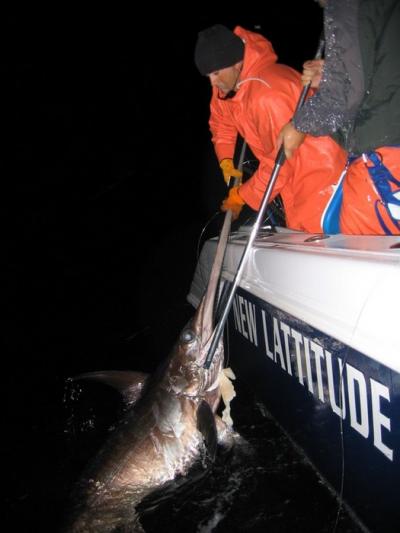Not to be confused with the Marlin family, south Florida has a big game Swordfish Fishery right off the coast. All you have to do is get past the shelf and you're in Swordfish territory 15 miles offshore. There is only one catch, you have to go at night and be prepared for anything to happen. Mako Sharks are in this body of water and have been caught by quite a few boats past the 700-pound mark. The Swordfish have been caught approaching this mark also.
Besides these large fish lurking these waters be prepared to weather a storm because it can approach in less than a moments notice. In August 2005 I remember fishing a Swordfish Tournament and all was quite as we were fishing comfortably waiting for the bite. We watched a storm at least 20 miles south of us but paid it no regard as it looked to have been moving straight east from its southern location. Then it was like someone turned on a switch as the winds picked up to 40+ knots with heavy rain and lightning. As we reeled in our gear it got worse. We were in the middle of this storm and had to be punished for the next 45 minutes as the wind and rain beat down on us as I tried to make it back to shore at 3-5 knots progressively. I regret my radar not working at the time. We could have seen the storm approach and wound things up earlier.
So a few things are necessary to have on your vessel when planning a trip to the Swordfish grounds for the evening. Having radar is important, as I have learned the hard way. Always do a bilge check to make sure things are in working order. There have already been some horror stories of boats taking on water out there in the middle of the night. If your fortunate, you might get some help from a nearby fisherman or else you might have to wait for the coast guard or Sea Tow. Make sure your navigation lights are working. This is most important when you move to reset your spread. You have to rely on other boats navigation lights to avoid a collision. So it works both ways.
There is nothing better than enjoying a successful Swordfishing excursion. In particular because we get to break in the good gear. On my boat we fish 80 w Shimano Tiagra reels with a few 50 w Tiagras as well. There will always be the debate on which way to spool it up. My preference is to go straight mono all the way to my swivel. I like to have no connections out there when I'm on a good fish. You might prefer to have a braid backing to get more yards on a 50 wide reel. I spool up with 80-pound mono on my 50's and 100 pound on all my 80 wides. Last year some time in September when we set up on our second drift Swordfishing, I had set our first bait in the water and within 1 minute of the line being set the bait light came racing for the surface. I came tight on the fish and wasn't impressed by his reaction. He actually swam right to the boat and I was able to grab the leader. The fish just swam to the boat and he just kept going tearing the leader out of my hands. The fish took a few dives almost straight down. His surges lasted for what seemed forever as the spool would just empty down to the bottom. The rod was doubled over hard with all that line straight up and down. It was the most insecure moment you could have knowing that he could just keep going and pop the knot or the line could snap.
Once you get past your line preference you have to think about leader material, length and strength. When you measure your length think of how it's going to go down when your fish comes to the boat. Swordfish have eyes the size of baseballs and hunt at night. So I prefer to use long leaders past 30 feet, keeping your swivel well away from the bait. I also attach my Electralume bait lights here. If your using light sticks they can be attached with rubber bands and you can go closer to the bait.
Be cautious if you go with long leaders because wiring these fish can get dangerous. Be prepared to dump the leader if your fish surges at the boat. Never take wrap your hand around the line because if you have to let go, these fish can surge at lightning speed. If there is anything caught in the way including your hand or fingers, they will get dragged overboard. One time I was wiring a small Swordfish that was all lit up at the boat, I had to release the leader and a loop caught my finger. As the fish took off, the loop from the leader synched down on my finger and took all the skin off my knuckle. I thought I lost the tip of my finger it hurt so badly. When leadering a fish make sure the angler points the rod tip away from you so you have room to drop the leader in the water. As you progress on leadering the fish, release the line to your side outside of the boat. That way if you have to let go of the leader, it can run away smoothly without any snags. We use 3-500 pound leaders mainly to help resist the abrasion.
Swordfish can come boat side quietly or fighting. Many times they come with their bill swinging. This can be intimidating to the leader man but you must keep steady leading him to the boat and in 1 motion gaff him in the gills. If you can keep his body in the water for a moment he can bleed out before you take him in the boat but watch for Sharks. Sometimes the Swordfish will have another Swordfish following them and swimming around the boat, so be ready to pitch another bait at them. If your going to release your fish it's best to cut the leader right at the boat and let the hook rust out. If you try to take the hook out be careful of the swinging bill. A heavy-duty pair of gloves will make you feel more confident in securing his bill. Be prepared if your fish makes a jump at the boat. They will jump into the boat. It's not a good idea for everyone on the boat to be crowded around the angler and leader man during this time. They need room to move away if the fish comes up and in the boat, especially with a fish that has a long sharp bill.
Choose a good hook in the 9/0 to 12/0 range. Some guys are experimenting with large circle hooks and having success. My hooks are Mustad J's and stainless J's crimped to the leader. When I crimp my hook to the leader I leave a tag end about 2 inches long for rigging purposes. When I rig my squid I insert the hook through the top of the mantle and pull it all through including the long tag end. Now my squid can hang on the tag end like on a coat hanger. You can then measure where the hook lies against the squid and reinsert the hook right through the center of the meat. This rig takes all of 15 seconds and swims very natural. If your squids don't look to fresh or are washed out, you can add some red food coloring to a bucket with some salt water in it. You can set this up on your way out so that when your ready to fish your baits will have soaked in that deep red color. Live bait is also a great option. I like to use any of the Runner species, Rainbows, Blues etc. In the wintertime the Tinker aka Boston Mackerel are abundant and work very well as a live presentation. All my live baits are bridled to their hooks.
When setting out my spread I start with my first bait around 100 feet deep. I attach a 1-2 pound lead with a long line clip 50-70 feet away from the bait to a permanent loop in the line I make with 90 lb wax line. As I'm at my 100-foot mark, another permanent loop, I attach my float by balloon or milk jug. I have a light stick attached to them for a visual when they're away from the boat. I attach my float with a rubber band. The same goes for the rest of the spread accept I will go deeper as I get closer to the boat with the #2, 3, or 4 rods. You want to keep your floats spread out and away from each other spacing them 70-100 feet apart. Most times a fish will take the bait and surface with it. The last rod I fish is set under the boat with no float. I can always reel in or let out this line anywhere from 50-400 feet below.
As you wait for the strike your drag settings should be carefully monitored. Some guys like to keep the drags loose with the clickers on and others keep their drags tight at all times. Either way you need to preset your drags anywhere from 12-25 pounds at strike. Setting your drag takes practice. I like to fish a heavy drag but that came after years of experience. It's just like King fishing; you will land more fish with a tighter drag from the run-off. You also will have the extra drag in case you need it on a very large fish.
Every night presents a different challenge with the weather. Your best success will be from drifting a perfect north course. The Gulf Stream in which you are fishing in moves along north at 1.5 to over 5 knots at times. With a good east wind you should be getting pushed inside, but sometimes the current will be moving northeast pushing you outside, even on an east wind. So monitor your GPS to see which way your drifting. A sea anchor comes in very handy and can help with your success. The anchor will stop your wind drift only, keeping you in the zone and current much longer.
You never know what you're going to get into out there. You might hear of a lot of small fish being caught but that doesn't mean to show up under-gunned. Just about everyone I know has had a shot at a very big fish. It can and will happen to you so be prepared.
See you on the rip,
Captain Cary Hanna
New Lattitude Sportfishing Charters
Ft. Lauderdale, Florida 954-907-0967
Captain Cary Hanna
www.newlattitude.com
954-907-0967




